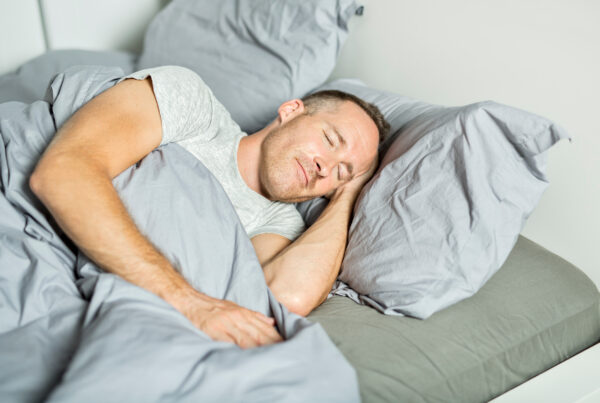”Question: Sleeping with pain impacts my life. What can I do to sleep better?
Reading time: 5 Minutes
MWi Hack:
-
Learn about the science of sleep, how sleep is connected to pain, and how to improve sleep as a way to lower pain levels.
MWi Summary:
-
- Good sleep is a combination of quantity and quality.
- Sleep is made up of REM (rapid eye movement) and NREM (non rapid eye movement). Dreams occur during REM sleep and NREM sleep is broken up into four stages.
- Poor sleep is connected to low-grade inflammation which can contribute to chronic pain. Pain itself can contribute to poor sleep as well.
- Cognitive Behavioral Therapy has been shown to help with sleep quality and quantity through a variety of methods:
- Stimulus control
- Relaxation training
- Biofeedback
- Cognitive therapy
- Sleep hygiene
Let’s Start with the Basics…The Anatomy of Sleep 101
Sleep can be broken down into two main parts – REM (rapid eye movement) and NREM (non-rapid eye movement). REM starts about 90 minutes after we fall asleep. The stages of REM sleep get longer and longer with the final one being about 1 hour. Dreams happen during REM sleep. The body also goes through many changes in REM sleep including faster breathing, increased brain activity, and muscle relaxation. NREM sleep is made up of 4 stages; stages 3 and 4 are the deep sleep stages. These stages are very important because the body repairs and regenerates tissues and strengthens the immune system during this time. As we get older we get less NREM sleep3. Both REM and NREM sleep are important in resetting our bodies in order to feel refreshed. When we get either decreased number of total hours or choppy sleep, the body is unable to go through the appropriate restorative stages.
Next up…. The Chemistry of Sleep
Bad sleep (either quantity or quality) can result in a low-grade inflammatory response due to increased levels of chemicals such as interleukin 6, prostaglandin E2 and nitric oxide4. Inflammation, as we know, is not good for the body or the mind. Other neurotransmitters in the brain such as dopamine and serotonin have been shown to help regulate sleep as well as pain. Although the exact mechanism by which these neurotransmitters affect our sleep is complex, their imbalance may play a role in sleep dysfunction in patient with chronic pain4.
The Vicious Cycle of Bad Sleep and Worsening Pain
On paper it makes sense…. when we are in a lot of pain, it is hard to sleep, and when we don’t sleep well, we have more pain. Scientific data supports this catch-22. In March 2019, a study by Krause found that acute sleep deprivation amplifies the pain signal in the human somatosensory cortex (as seen on functional MRI) and lowers the threshold for what the body/brain considers to be painful5. Compared to chronic pain patients without sleep issues, those with bad sleep reported more severe pain, greater levels of anxiety/depression and impairments in physical functioning6 .
Lets Talk Action! What Can Be Done?
Treating poor sleep is as difficult as treating chronic pain. There is no simple answer or one size fits all option. The seemingly simple solution of taking a “sleeping pill” does not always end up being as simple as it seems. Many of these medications have side effects that are not easily tolerated, and many have interactions with other drugs one might be taking. In addition, pain medications including opioids also impact the sleep-wake cycle by decreasing the total amount of REM and deep sleep thereby worsening sleep while attempting to treat pain4.
Cognitive Behavioral Therapy for Insomnia (CBT-I) 7 has been shown to have a positive and lasting impact on sleep and pain management. Some important aspects include:
1). Stimulus control – go to bed early, use bed/bedroom only for sleep and sex, get out of bed when cannot fall asleep within 15-20 min, avoid naps.
2). Relaxation training – used to reduce sleep interfering somatic or cognitive tension at or around bedtime.
3). Biofeedback – using visual or auditory feedback to help increase control over biologic responses (ex heart rate, muscle tension).
4). Cognitive therapy – identifying unhelpful and challenging thoughts about sleep and replacing them with helpful substitutes through discussion. Stressing over bad sleep makes sleep itself worse!
5). Sleep Hygiene – quiet/clean bedroom, dietary changes (avoid alcohol and caffeine), behavioral changes (exercise can improve sleep leading to better mood and a healthy level of fatigue at end of day to promote good sleep).






